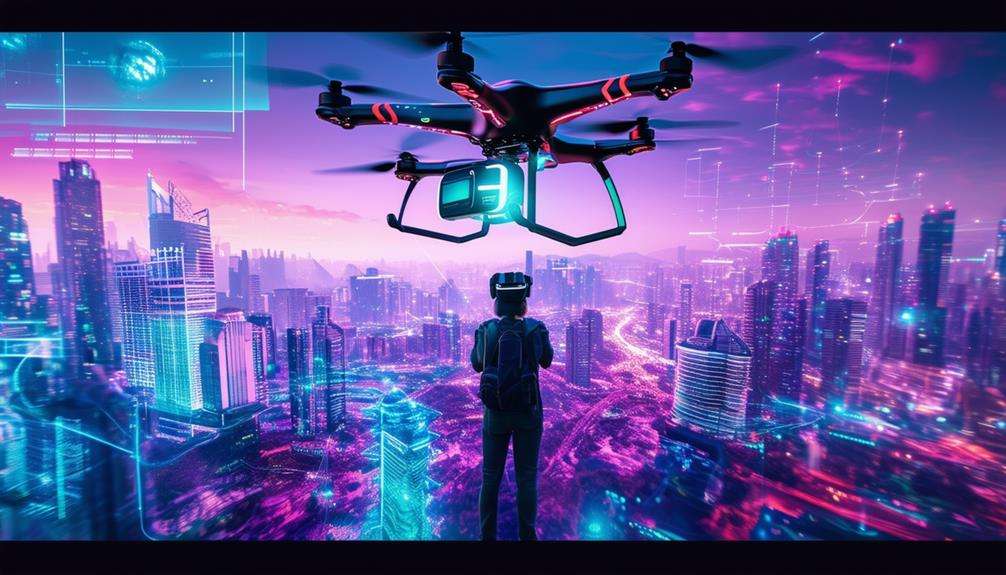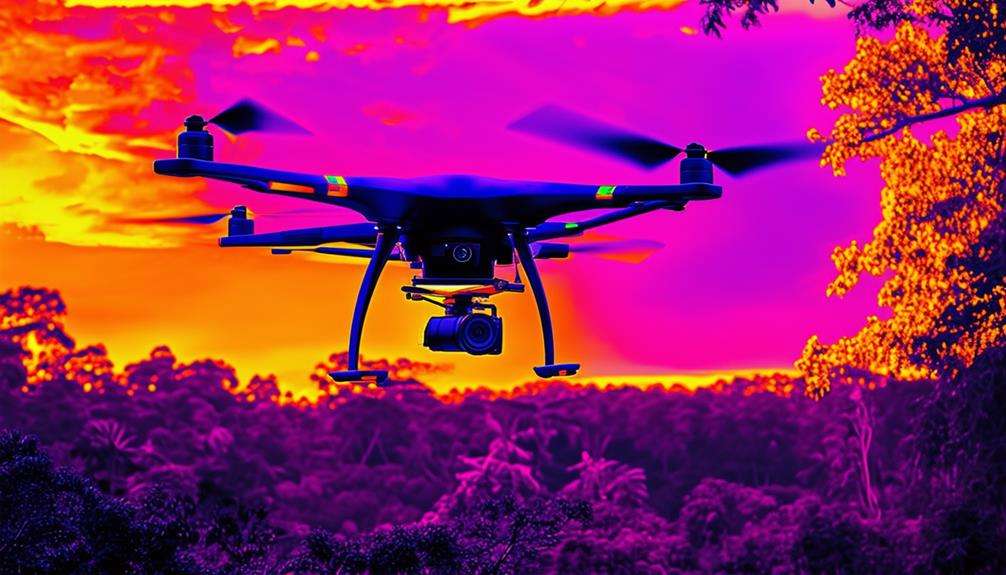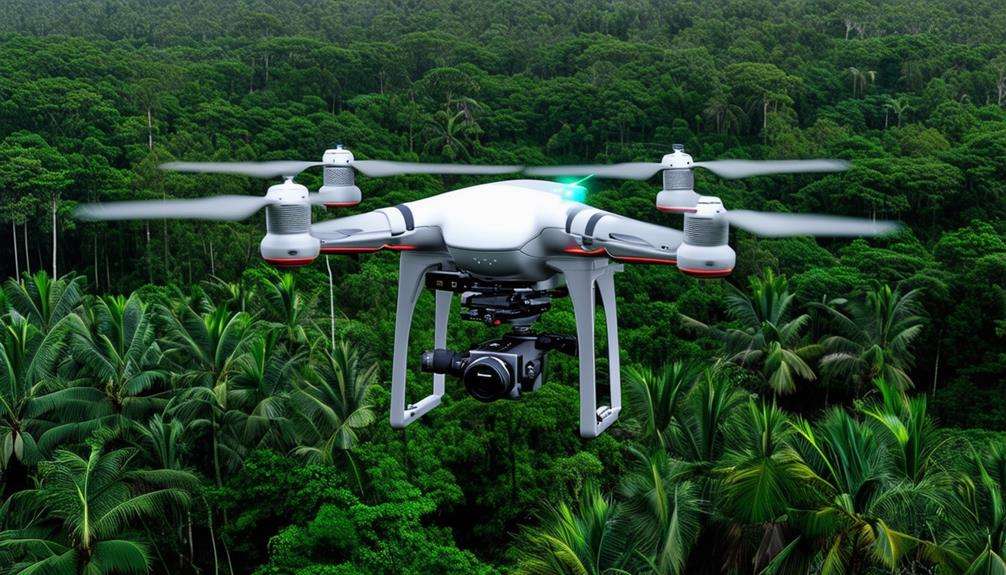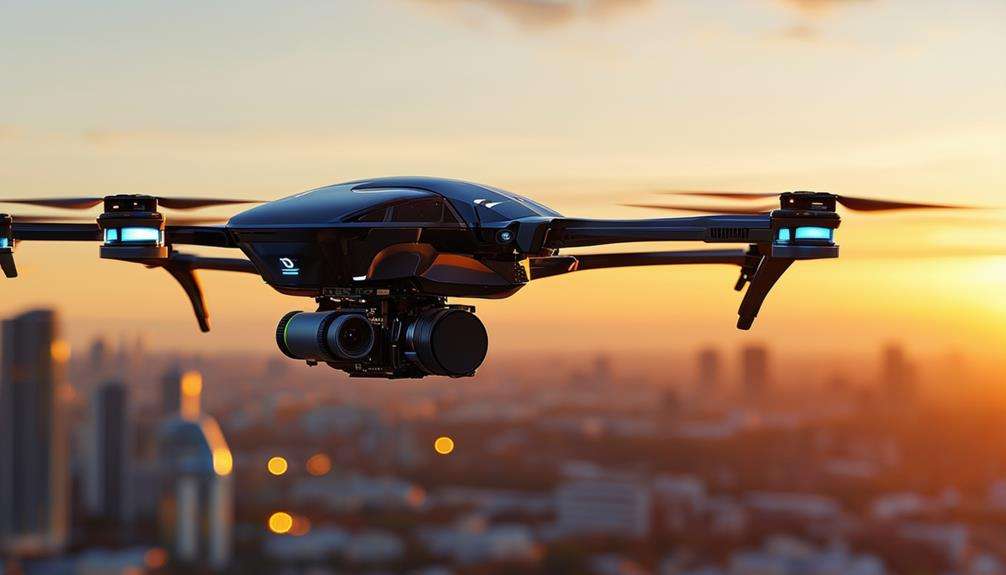Drone Innovations: The Latest in UAV Technology
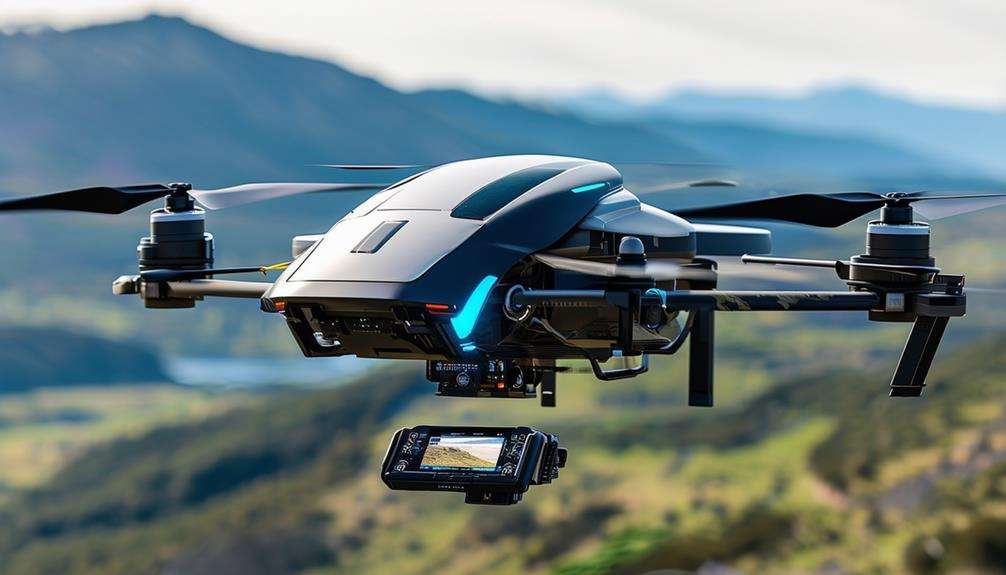
We're in the midst of a transformative era in UAV technology, where drone innovations are setting new standards. Picture drones outfitted with high-resolution thermal cameras, poised to revolutionize agricultural assessments and infrastructure inspections. Real-time kinematic navigation is pushing data collection accuracy to unprecedented levels.
But that's just the beginning. Imagine the impact of combining advanced AI for autonomous flight planning with the collaborative capabilities of drone swarming technology. These advancements offer just a glimpse of the evolving potential in the drone industry, with many more groundbreaking developments on the horizon. Are you ready to explore the full scope of what drones can achieve?
High-Resolution Thermal Cameras
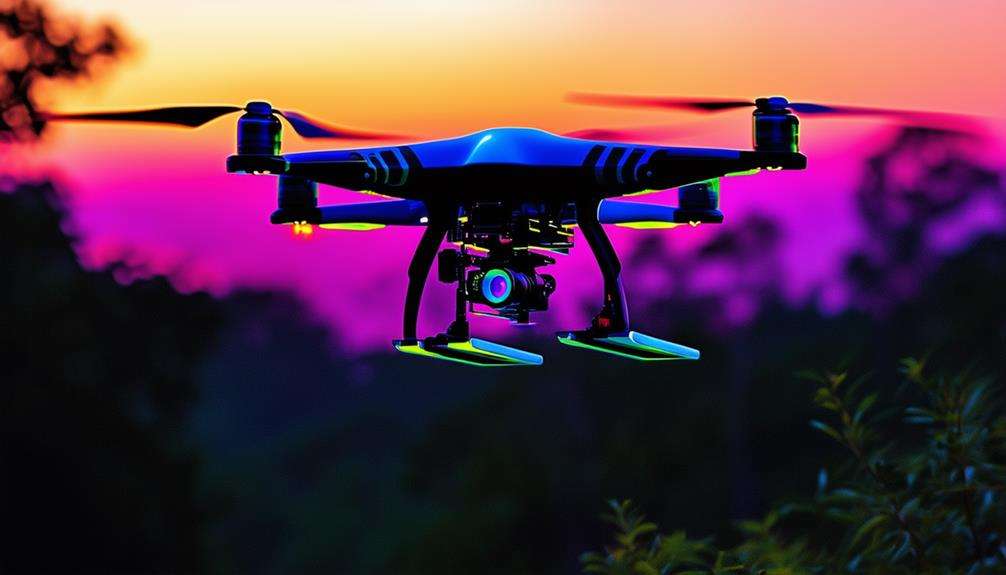
High-resolution thermal cameras integrated into drones enable the capture of detailed thermal images, essential for precise analysis across various industries. These advanced thermal imaging systems offer exceptional temperature sensitivity and spatial resolution, making them invaluable for accurate thermal mapping and analysis.
Utilizing drones equipped with high-resolution thermal cameras enhances capabilities in geospatial applications. In agriculture, these cameras detect temperature variations, indicating water stress or disease in crops.
For infrastructure inspections, UAVs can survey buildings, bridges, and power lines, identifying potential issues without direct contact. In search and rescue operations, thermal imaging locates missing persons by sensing body heat, even in challenging environments.
Environmental monitoring also benefits, as these cameras can track wildlife, monitor forest health, and detect wildfires early. These applications demonstrate the broad utility and precision of high-resolution thermal cameras in UAVs, making them indispensable tools for modern industry and environmental management.
Real-Time Kinematic Navigation
Building on the precision offered by high-resolution thermal cameras, Real-Time Kinematic (RTK) navigation elevates drone accuracy to the next level by providing centimeter-level positioning data. RTK technology achieves this by using a base station to transmit real-time corrections to the drone, ensuring it knows its exact location with unprecedented accuracy.
For geospatial data collection in mapping and surveying, RTK-enabled drones offer a significant advantage. They ensure precise data collection, reducing errors and improving the quality of your results. This high level of accuracy is invaluable in fields such as agricultural monitoring, where precise geospatial data informs better crop management decisions, and in construction site surveys, where exact measurements are essential for planning and building.
RTK navigation is a game-changer for any task requiring precise positioning. By minimizing errors and enhancing efficiency, it allows you to complete your work faster and with greater confidence in the accuracy of your data.
Advanced AI in Drones
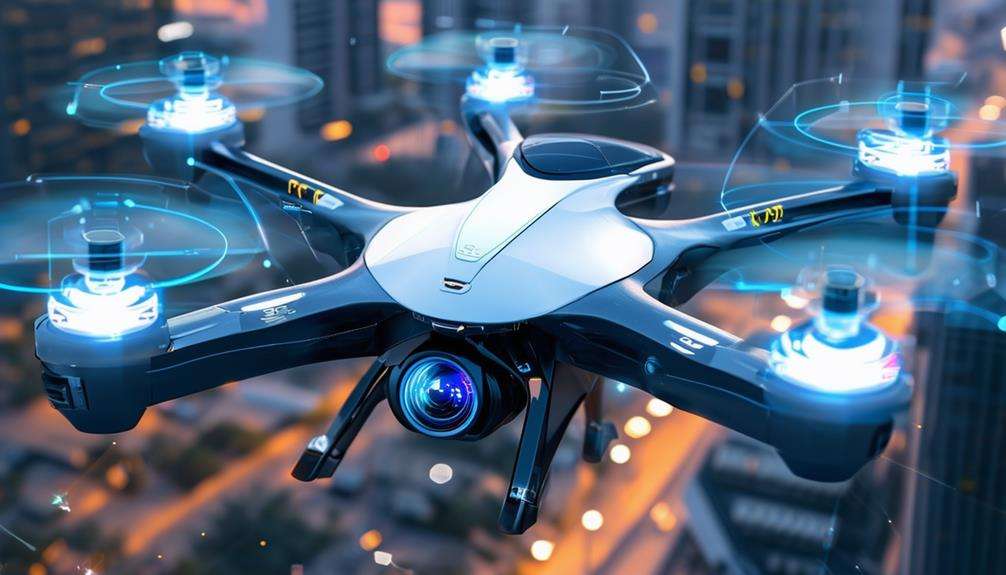
AI and machine learning are transforming drones, empowering them to navigate autonomously and efficiently manage various environments. Companies like Skydio and Maris-Tech are at the forefront of this innovation, enabling drones to learn, adapt, and make decisions without human intervention. Picture a drone seamlessly navigating dense forests or urban areas, avoiding obstacles, and completing tasks autonomously - that's the essence of advanced navigation.
These sophisticated AI systems also facilitate real-time data analysis, making drones indispensable across multiple industries. Outfitted with high-resolution cameras and sensors, drones can gather and process data instantaneously, delivering actionable insights in real time. Whether it's monitoring agricultural fields, inspecting infrastructure, or conducting search and rescue operations, the efficiency and productivity benefits are significant.
AI-driven drones aren't a futuristic concept; they're a present reality and are rapidly advancing. The market for AI in drones is expected to soar to $6.5 billion by 2027, underscoring their increasing relevance and adoption. Ongoing innovation in AI integration is continually enhancing the capabilities and reliability of drone technology, ensuring they become even more effective in the future.
Drone Swarming Technology
Drone swarming technology revolutionizes how multiple drones can collaborate to cover extensive areas and accomplish tasks more efficiently. By coordinating multiple UAVs, drone swarming ensures faster and more effective task completion compared to individual drones. Verity Studios is a pioneer in this field, leveraging swarm technology for both entertainment and critical missions, such as search and rescue.
In emergency situations, time is of the essence, and drone swarming can significantly improve response times. Swarms of drones can quickly locate and reach victims, providing essential assistance when every second counts. For instance, in the event of a natural disaster, a well-coordinated swarm can scan large areas, identify survivors, and relay their locations to rescue teams much faster than traditional methods.
The applications of drone swarming extend beyond emergencies. Various industries are increasingly recognizing the benefits of collaborative drone operations, leading to a growing market for this technology. Efficient swarms can tackle tasks ranging from agricultural monitoring to environmental surveys, showcasing their versatility. As drone swarming technology continues to evolve, it's expected to reshape different sectors through even more innovative applications.
Autonomous Flight Planning
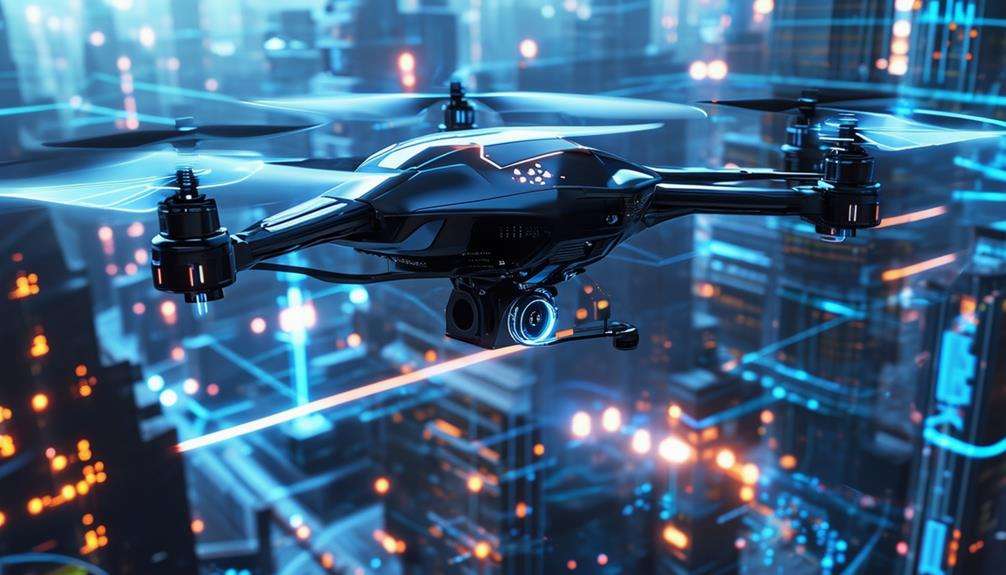
Utilizing AI algorithms, autonomous flight planning optimizes drone routes and mission parameters for enhanced efficiency and precision. These advanced systems enable drones to autonomously plan routes, avoid obstacles, and adapt in real-time to changing environmental conditions. This significantly reduces the need for human intervention, allowing you to allocate your focus to other critical tasks.
Autonomous flight planning offers more than just convenience; it enhances overall performance. Drones equipped with these capabilities can cover larger areas, collect data with higher accuracy, and complete tasks more rapidly. This technology proves beneficial across various applications, including search and rescue operations, surveillance, and precision agriculture.
Here's a quick comparison to highlight the advantages:
| Feature | Manual Flight Planning | Autonomous Flight Planning |
|---|---|---|
| Human Intervention | High | Low |
| Data Collection Accuracy | Moderate | High |
| Area Coverage | Limited | Extensive |
Amphibious Drone Systems
Amphibious drone systems can revolutionize operations with their ability to land on water and advanced hybrid designs. These versatile drones excel in both air and water environments, making them ideal for various applications. Imagine the potential for efficient exploration and data collection in even the most challenging terrains.
Water-Landing Capabilities
Imagine a drone that seamlessly transitions from soaring in the sky to diving beneath the water's surface. Amphibious drones are transforming UAV technology with their dual capabilities and innovative designs. These drones can effortlessly switch between air and water modes, harnessing the strengths of both environments. By emulating natural behaviors, they enhance energy efficiency, using underwater currents to conserve power.
| Airborne Mode | Water-Landing | Underwater Mode |
|---|---|---|
| High speed | Smooth descent | Stealthy movement |
| Wide coverage | Minimal splash | Detailed exploration |
| Easy navigation | Stability | Extended battery life |
| Real-time data | Quick adjustment | Improved maneuverability |
| Versatile use | Energy-efficient | Advanced sensors |
These drones excel in aquatic environments where traditional UAVs struggle. Their water-landing capabilities enable them to conduct precise operations without damaging sensitive equipment. Whether for environmental monitoring, underwater surveys, or rescue missions, these drones offer unparalleled versatility.
The innovative designs ensure the drones can handle diverse tasks efficiently. With amphibious drones, you are not only navigating the skies but also exploring underwater realms. This technology unlocks new possibilities for research, disaster response, and environmental conservation. It represents a significant advancement in both aerial and underwater exploration.
Versatile Environmental Applications
Amphibious drone systems, which integrate multicopter and underwater technologies, are transforming environmental applications by efficiently operating in both air and water. These innovative drones offer versatile environmental monitoring, search and rescue capabilities, and the exploration of difficult terrains.
Picture a drone that can fly over a forest, land on a river, and then dive underwater to continue its mission. This is the capability of amphibious drone systems. They're engineered to adapt to a variety of environments, significantly expanding their operational range and functionality.
A notable feature is the remora-inspired disc that allows these drones to attach to larger underwater vehicles such as submarines. This ingenious mechanism conserves energy, permitting the drones to conduct prolonged operations without frequent recharges. By emulating the natural efficiency of remoras, these drones can remain active longer and cover more territory—both in the air and underwater.
With this advanced technology, you aren't merely acquiring a drone; you're gaining a multi-environmental tool capable of addressing diverse tasks efficiently. Amphibious drone systems are leading the way in inclusive and effective environmental management solutions, ensuring that no terrain is insurmountable.
Hybrid Design Innovations
Hybrid design innovations in UAV technology are expanding the capabilities of drones by integrating the advantages of both aerial and underwater vehicles into a single multifunctional system. These amphibious drones can effortlessly transition between flying over rugged terrains and diving into underwater environments, offering unparalleled operational versatility.
Envision a drone that can navigate through mountainous regions and then dive into the ocean to explore underwater ecosystems. These drones employ bio-inspired mechanisms such as bird-like energy-efficient landings and remora-like suction discs for attaching to submarines.
By emulating these natural strategies, amphibious drones can conserve energy and extend their operational range. For example, the remora-inspired disc enables the drone to latch onto moving submarines, conserving battery life and allowing for greater travel distances.
These advanced capabilities open up new possibilities for research, investigation, and surveillance in challenging environments where traditional drones fall short. Whether it's monitoring marine ecosystems, inspecting underwater infrastructure, or conducting aerial surveys, amphibious drone systems are transforming the way we approach complex tasks.
Solar Panel Cleaning Drones
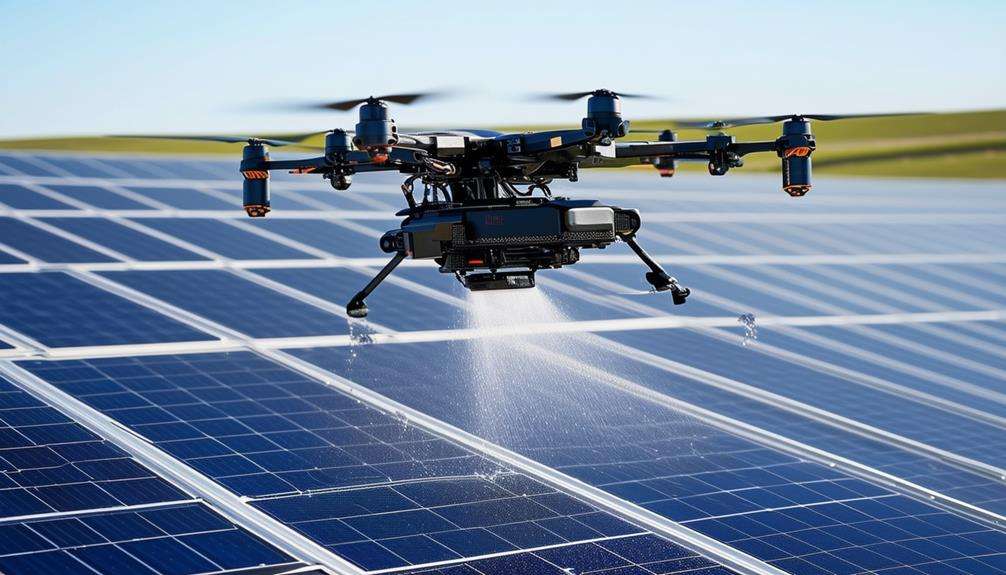
Solar panel cleaning drones are transforming solar maintenance by enhancing efficiency. These drones employ advanced cleaning mechanisms to maintain spotless panels, ensuring maximum energy production.
Efficiency in Solar Maintenance
Solar panel cleaning drones, equipped with advanced RDS2 technology, significantly enhance energy production and system reliability. Integrating these drones into your solar maintenance routine optimizes the efficiency of your solar panels. RDS2 technology ensures precise and thorough cleaning, removing dust and debris that can block sunlight and reduce energy output.
Advanced Cleaning Mechanisms
Utilizing cutting-edge technology, these drones offer unparalleled precision in cleaning solar panels, ensuring optimal energy efficiency. An automated system with two drones can significantly enhance the performance of your solar panels, eliminating the need for manual labor, which reduces maintenance costs and boosts energy production.
Incorporating drone technology into your solar panel maintenance routine not only improves the longevity but also the effectiveness of your solar panel systems. Equipped to handle a variety of cleaning tasks, these drones are both versatile and reliable.
Key benefits include:
- Efficiency: The automated system deploys two drones to clean large arrays swiftly and thoroughly.
- Cost Savings: Minimizing the need for manual labor substantially cuts maintenance expenses.
- Improved Performance: Clean panels lead to higher energy output and efficiency.
- Safety: Drones manage dangerous or hard-to-reach areas, reducing risks to human workers.
- Longevity: Regular cleaning by drones enhances the lifespan of your solar panels.
Environmental Impact Reduction
Using solar panel cleaning drones significantly reduces water usage and eliminates the need for chemical cleaners, making solar energy maintenance both eco-friendly and efficient. These drones use automated systems with detachable net-pulling propellers to remove dirt, dust, and debris, ensuring that solar panels operate at peak efficiency. Regular cleaning with drones enhances energy production and extends the lifespan of the panels.
Drone technology has revolutionized solar panel maintenance by reducing the need for manual labor and minimizing the environmental footprint of these activities. These automated cleaning systems not only boost energy output but also integrate seamlessly with existing environmental monitoring systems. This ensures that solar panels are well-maintained without harming the surrounding ecosystem.
Moreover, the use of solar panel cleaning drones aligns with advancements in drone delivery and other UAV applications, demonstrating the versatility of these technologies. By adopting these drones, you contribute to a more sustainable future where cutting-edge technology and environmental preservation coexist harmoniously.
Ornithopter Perching Mechanisms
Imagine a drone that can perch like a bird, utilizing advanced mechanisms to enhance agility and energy efficiency. That's precisely what the P-Flap ornithopter achieves. By incorporating bird-like perching mechanisms, this innovative UAV significantly improves its agility and can loiter in one spot for extended periods.
Traditional flapping-wing drones often face limitations, but the ornithopter's claw mechanism enables precise landing and take-off capabilities, making it a groundbreaking advancement in the field.
The ornithopter's perching mechanism doesn't just enhance agility; it also improves maneuverability and control during operations. This technology offers a unique solution for drones to land and perch in challenging environments, expanding their usability in various applications.
Key features of the ornithopter's perching mechanism include:
- Energy Efficiency: Perching allows the drone to conserve energy by resting between flights.
- Precision Landing: The claw mechanism ensures accurate and stable landings on different surfaces.
- Extended Loitering: The ability to stay perched for longer periods makes it ideal for surveillance and monitoring tasks.
- Improved Control: Enhanced maneuverability allows for better control in tight or complex environments.
- Versatility: Adaptable to both urban and natural settings, providing flexibility in perching spots.
This technology represents a significant leap in UAV capabilities, making drones more efficient and adaptable for various applications.
3D-Printing Aerial Drones
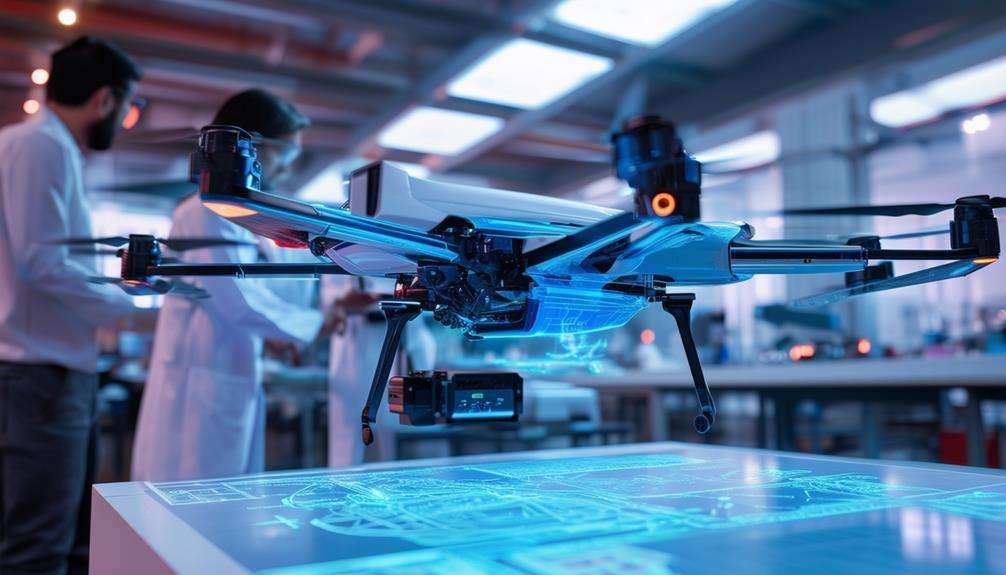
While the ornithopter's perching mechanisms push the boundaries of drone agility and control, 3D-printing aerial drones are transforming the construction industry by autonomously building structures in challenging-to-reach locations.
Inspired by the behavior of bees, these drones navigate and construct in areas that are too remote or hazardous for traditional construction methods. No longer are cumbersome cranes or scaffolding required, as these flying 3D-printing units manage both heavy lifting and intricate detailing.
Imagine a construction site where drones are buzzing around like bees, methodically depositing layers of material to create complex structures. This isn't just a futuristic concept; it's happening now. These drones enhance construction efficiency and sustainability. They can operate in places inaccessible to human workers, thereby reducing risks and accelerating project timelines.
The use of drone technology for 3D-printing in construction also paves the way for innovative and eco-friendly building practices. By mimicking the efficient, collective behavior of bees, these drones provide a unique solution for constructing buildings in remote or difficult-to-access areas. They aren't merely changing how we build; they're redefining the possibilities within the construction industry.
Conclusion
You've only just begun to explore the latest innovations in drone technology. Equipped with high-resolution thermal cameras, real-time kinematic navigation, and advanced AI, drones are becoming increasingly intelligent and efficient.
Developments such as drone swarming technology, autonomous flight planning, and amphibious capabilities are extending their functionality. From solar panel cleaning and ornithopter perching to 3D-printing from the air, the future of UAV technology is promising and filled with potential. Stay tuned—these advancements are revolutionizing the industry!

